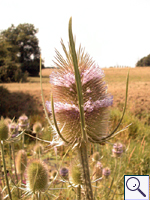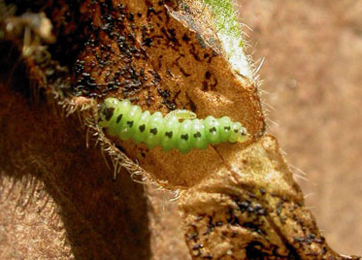|
||||||
|
DIPSACUS. Teasels. [Dipsacaceae] |
|
|
Five species of Dipsacus are recorded in Britain. These include the native Wild Teasel (D. fullonum) and Small Teasel (D. pilosus). Five British m iners are recorded on Dipsacus. A key to the European miners recorded on Dipsacus is provided in Bladmineerders van Europa. |
 Wild Teasel Dipsacus fullonum |
Key for the identification of the known mines of British |
1a > Leaf-miner: Larvae feeding primarily along mid-rib, forming short lateral mines into the leaf blade. Pupation within the mid-rib. the corridors are short in Dipsacus, but longer in Knautia and Succisa. (Spencer, 1976: 480). The larvae essentially is a borer in the midrib, but makes from there narrow corridors into the blade. In the end also a corridor can be made on top of the midrib. Most frass is deposited within the midrib, to a lesser extent also in the corridors, at the point where they leave the midrib (Hering, 1957, 1967a). Pupation in the mine, generally in the basal part of the tunnel in the midrib, just below the upper epidermis. The larva feeds along the midrib, making short corridors into the leaf. |
|
Chromatomyia ramosa (Hendel, 1923) [Diptera: Agromyzidae]. |
1b> Leaf-miner: A funnel-shaped blotch mine at margin of leaf (Spencer, 1972b: 36 (fig. 100), 38). Forms a long mine, which rapidly broadens, at the leaf edge. The mine turns brown.. Blotch, invariably beginning at the leaf margin, widening fast and strongly, giving the mine a funnel-like shape. Primary and secondary feeding lines very conspicuous. Frass in large grains. The larvae leaves the mine before pupation; according to Spencer (1954) the exit slit is in the lower epidermis. |
|
|
1c > Leaf-miner: Full depth, transparent blotch. Oviposition site, at the leaf upper surface, covered by a brownish black drop of hardened secretion. Frass in granules or thread fragments. Pupation in the mine, not in a cocoon. |
 Trachys troglodytes larva, dorsal Image: © Steve Wullaert (Bladmineerders van Europa) |
|
Trachys troglodytes Gyllenhal, 1817 [Coleoptera: Buprestidae]. |
1d > Leaf-miner: Large, lower-surface tentiform mine with several folds that cause the leaf to contract strongly. Leaf around the mine often coloured violet. Pupa in a cocoon, frass in a corner of the mine. Mainly on seedlings and ground leaves . |
|
| Phyllonorycter scabiosella (Douglas, 1853) [Lepidoptera: Gracillariidae]. |
1e > Leaf-miner: A narrow winding linear mine generally near the apex of the leaf which assumes a striking purplish colour, making the mine itself difficult to detect. Mines have also been found in the sepals. Pupation takes place in a puparial cradle on the lower surface (Spencer, 1976: 510). Very long, often branched corridor, narrow till very end, for much of its length lower-surface, mostly in the apical part of the leaf. The corridor frequently intersects itself. Frass in discrete grains. Pupation in the mine, Around the mine the leaf almost always turns violet. |
|
Chromatomyia succisae (Hering, 1922) [Diptera: Agromyzidae]. |
| Last updated 04-Jul-2019 Brian Pitkin | ||
